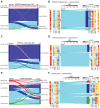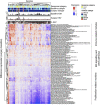Impact of Duration of Neoadjuvant Aromatase Inhibitors on Molecular Expression Profiles in Estrogen Receptor-positive Breast Cancers
- PMID: 34965950
- PMCID: PMC7612503
- DOI: 10.1158/1078-0432.CCR-21-2718
Impact of Duration of Neoadjuvant Aromatase Inhibitors on Molecular Expression Profiles in Estrogen Receptor-positive Breast Cancers
Abstract
Purpose: Aromatase inhibitor (AI) treatment is the standard of care for postmenopausal women with primary estrogen receptor-positive breast cancer. The impact of duration of neoadjuvant endocrine therapy (NET) on molecular characteristics is still unknown. We evaluated and compared changes of gene expression profiles under short-term (2-week) versus longer-term neoadjuvant AIs.
Experimental design: Global gene expression profiles from the PeriOperative Endocrine Therapy for Individualised Care (POETIC) trial (137 received 2 weeks of AIs and 47 received no treatment) and targeted gene expression from 80 patients with breast cancer treated with NET for more than 1 month (NeoAI) were assessed. Intrinsic subtyping, module scores covering different cancer pathways and immune-related genes were calculated for pretreated and posttreated tumors.
Results: The differences in intrinsic subtypes after NET were comparable between the two cohorts, with most Luminal B (90.0% in the POETIC trial and 76.3% in NeoAI) and 50.0% of HER2 enriched at baseline reclassified as Luminal A or normal-like after NET. Downregulation of proliferative-related pathways was observed after 2 weeks of AIs. However, more changes in genes from cancer-signaling pathways such as MAPK and PI3K/AKT/mTOR and immune response/immune-checkpoint components that were associated with AI-resistant tumors and differential outcome were observed in the NeoAI study.
Conclusions: Tumor transcriptional profiles undergo bigger changes in response to longer NET. Changes in HER2-enriched and Luminal B subtypes are similar between the two cohorts, thus AI-sensitive intrinsic subtype tumors associated with good survival might be identified after 2 weeks of AI. The changes of immune-checkpoint component expression in early AI resistance and its impact on survival outcome warrants careful investigation in clinical trials.
©2021 The Authors; Published by the American Association for Cancer Research.
Figures






References
-
- Dunbier AK, Ghazoui Z, Anderson H, Salter J, Nerurkar A, Osin P, et al. . Molecular profiling of aromatase inhibitor – treated postmenopausal breast tumors identifies immune-related correlates of resistance. Clin Cancer Res 2013;19:2775–86. - PubMed
Publication types
MeSH terms
Substances
Grants and funding
LinkOut - more resources
Full Text Sources
Other Literature Sources
Medical
Research Materials
Miscellaneous

